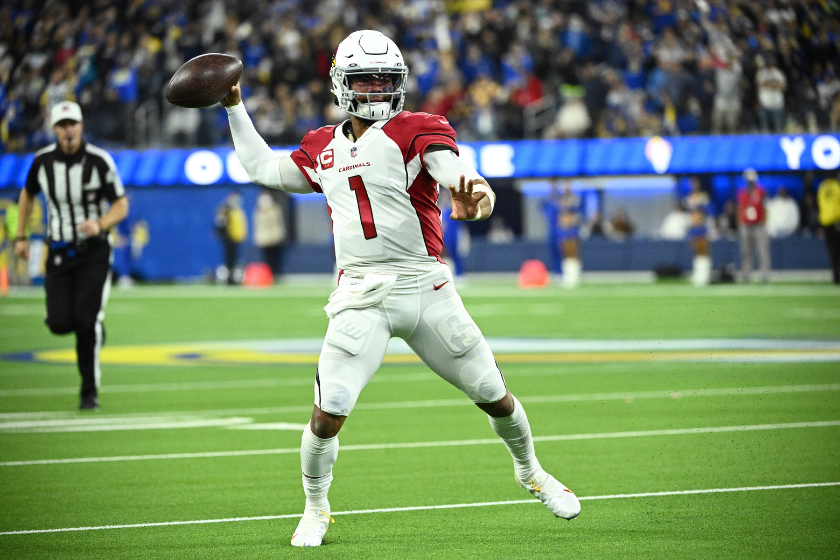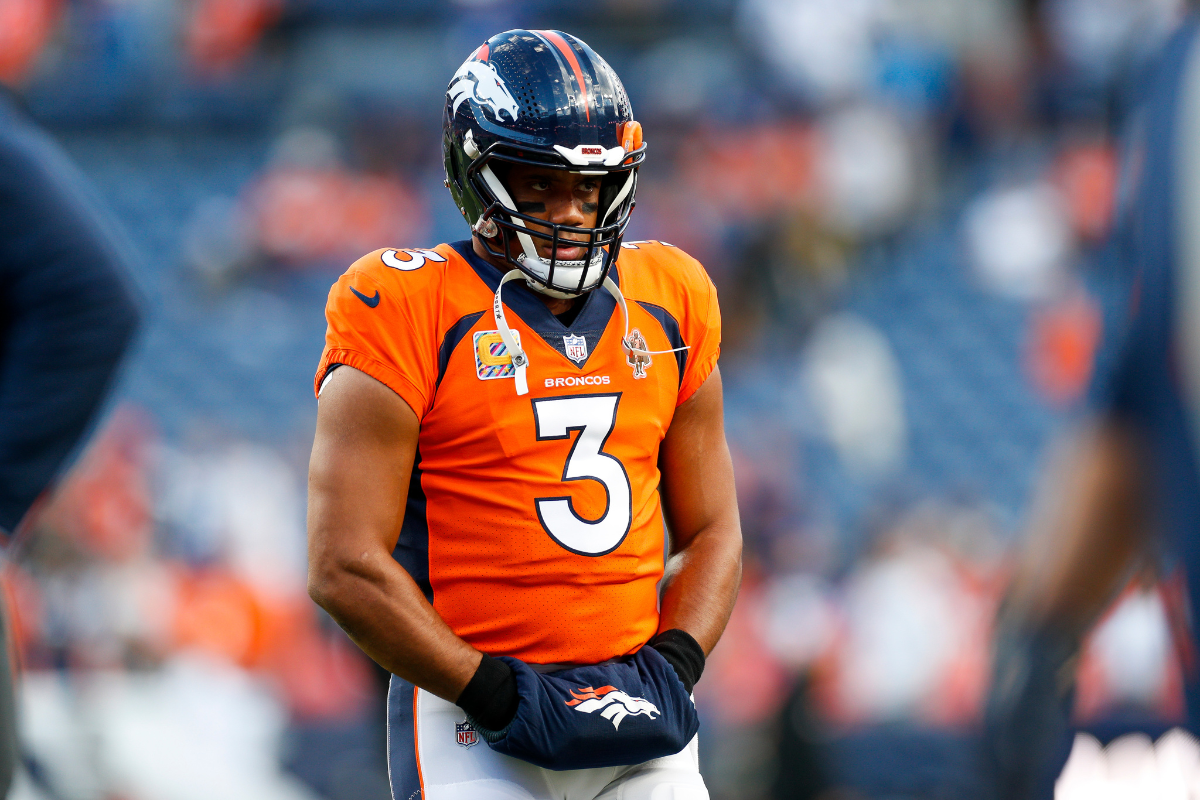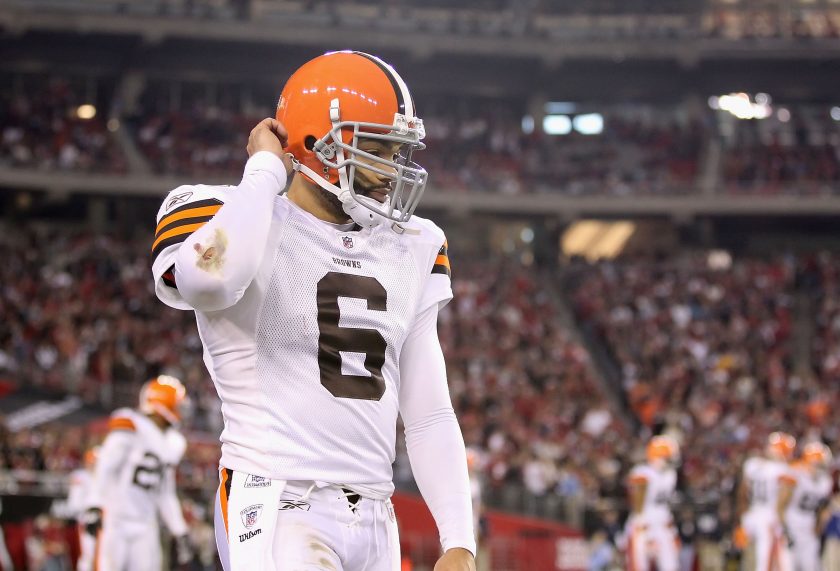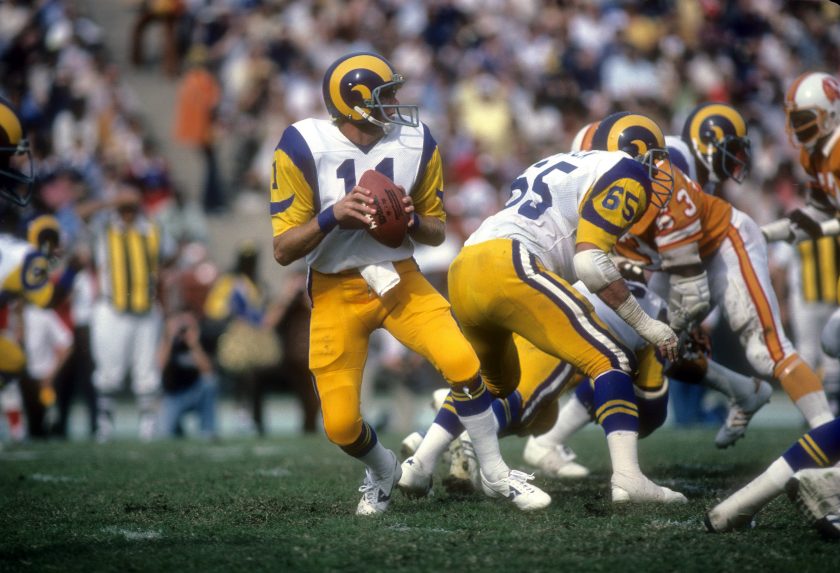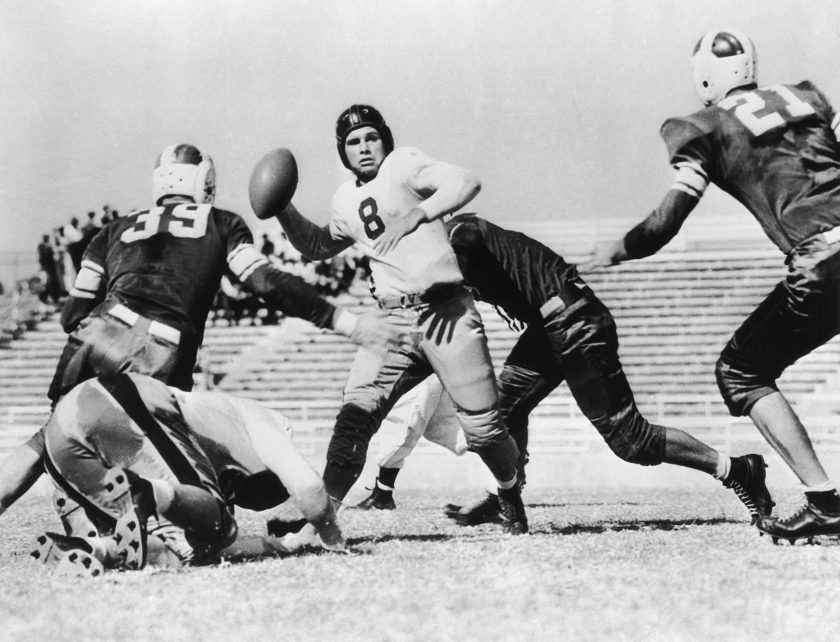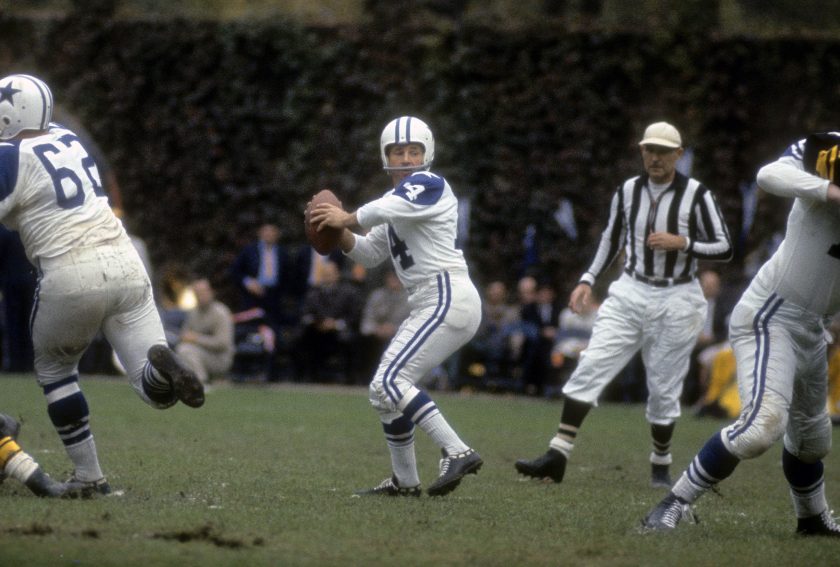As we head toward the 2023 NFL Draft, the Carolina Panthers hold the No. 1 overall pick after swinging a trade with the Chicago Bears.
Videos by FanBuzz
The odds-on favorite to go No. 1 overall is Alabama Crimson Tide quarterback Bryce Young. Young has all the tools you'd want in an NFL quarterback and NFL player: solid enough arm strength, a remarkable ability to read the field, elite playmaking ability, and a knack for creating plays. Despite this, Young should land with the Panthers or the Houston Texans at No. 2 overall.
There's one knock on Young: his size. At 5-foot-10 and less than 205 pounds, Young will be the smallest starting quarterback in the league. Regarding size, the concern for many could be needing big drop-backs to see over the offensive line, as well as batted passes and durability.
Here, we'll look back at nine quarterbacks listed at below six feet tall who have played in the NFL and see how their careers went or are going. Of course, it will never be a one-to-one comparison, as all players are different. Still, it's worth examining the shortest NFL quarterbacks ever to play to see if they've succeeded.
We'll start with the incumbent starter of the Arizona Cardinals.
Kyler Murray
RELATED: Bryce Young's Height Would Put Him in Rare First-Round Territory
Height: 5-10
Drafted No. 1 overall in the first round of the 2019 NFL Draft, Kyler Murray is currently the smallest quarterback starting in the NFL. He's the same height as Young at 5-foot-10, but he weighs just a few pounds more.
While they're comparable in this regard, the Cardinals signal-caller has one trait that Young doesn't possess: speed. Murray's speed has allowed the Cardinals' offense to operate in a way that the Panthers — should they take Young No. 1 overall — won't entirely be able to do. However, Young plays more like Drew Brees than Murray or Russell Wilson.
We should also remember that coming out of Oklahoma, a non-SEC school, Murray had just one year of starting experience. In contrast, Young has had two, plus minimal action in his freshman season.
Murray, who's currently dealing with a torn ACL from a non-contact injury, is set to miss a good portion of the 2023 season. Before this, he missed five games due to injuries such as an ankle sprain and hamstring strain.
Russell Wilson
Height: 5-11
An easy comparison for Murray coming out of school, former Seattle Seahawks and current Denver Broncos quarterback Russell Wilson was known as the smallest quarterback to have NFL success.
Like Murray, Wilson — who's still one of the shortest QBs — also had speed and could run. He's not quite at Murray's level, perhaps, but quite close.
Wilson was drafted in the third round and 75th overall by the Seahawks in the 2012 draft. He spent three seasons at North Carolina State and his final college season at Wisconsin.
Coming out, Wilson ran a 4.55 40-yard dash at the NFL Combine. If you look at his scouting report from NFL Network under weaknesses, it says the following: "Wilson's height will be his biggest inhibitor at the next level and the largest reason for his late-round value."
Of course, this is something that scared off NFL teams, resulting in him dropping to the third round. But coming out of school, he was an accurate passer, had command of the offense, and had solid arm strength — yet, like Young, the size is what scared teams off.
As we now know, Wilson would go on to start in his rookie season despite the team signing Green Bay Packers flash-in-the-pan Matt Flynn.
Before last season, he never had fewer than 20 passing touchdowns in a season, and he had a winning record as a starter every year besides 2021 and 2022. He also won Super Bowl XLVIII in 2014 against the Denver Broncos 43-8 and has played in many Pro Bowls.
P.J. Walker
Height: 5-11
OK, we've covered Murray and Wilson, the obvious ones who have had success in the NFL, but now we'll touch on some guys who have played in the NFL but haven't enjoyed nearly that level of success.
Undrafted in 2017 out of Temple, P.J. Walker — currently 28 years old — was signed by the Colts as an undrafted free agent, was waived a few months later, but then immediately was signed to the practice squad. He spent time off and on the Colts' practice squad through Aug. 31, 2019, before ultimately getting released.
Listed at just over 5-foot-11 and 214 pounds, Walker had some speed but not nearly on the level of Wilson or Murray, running a 4.74 40-yard dash.
After getting released by the Colts, Walker was drafted by the recently reformed XFL. The Pittsburgh Steelers tried to sign Walker, but the XFL didn't allow it because he was then under contract with the XFL. Walker enjoyed success in the XFL overall despite a play in which he kneeled on fourth down, but the season was cut short due to the COVID-19 pandemic. He finished the year going 5-0 with 1,338 passing yards, 15 touchdowns and four interceptions.
A few days after the season was canceled, Walker signed a two-year deal with the Carolina Panthers worth around $1.5 million. This allowed him to reunite with Matt Rhule, who was his coach at Temple.
Since then, Walker has started seven games as an NFL QB and has appeared in 15. He's completed 57.5% of his passes for five touchdowns and 11 interceptions.
Seneca Wallace
Height: 5-11
The Seahawks seem to have an affinity for undersized quarterbacks.
In 2003, the team drafted Seneca Wallace 110th overall in the fourth round out of Iowa State. Running a 4.56 40-yard dash, Wallace had escapability. Still, over his 22 career starts, he only had 68 rushing attempts for 293 yards and one touchdown.
Wallace served as a steady backup quarterback option to Matt Hasselbeck. Still, he got involved in other ways outside of playing the position. In the 2005 playoffs, he had an athletic 28-yard catch from Hasselbeck against the Panthers in the NFC championship. During his stint with the Seahawks, he started 14 games, going 5-9 with a completion rate of 59.9%, with 25 touchdown passes and 14 interceptions.
After playing with the Seahawks, he signed with the Cleveland Browns, again serving as a backup. This time, it was for Jake Delhomme. He started seven games for the Browns, going 1-6 with just six touchdown passes. He signed another three-year deal with the team in 2011 but was released after the 2012 season.
Wallace would start one more game in his NFL career, for the Green Bay Packers in 2013. He completed 16 of 24 passes for 139 yards and an interception, resulting in a loss.
Pat Haden
Height: 5-11
Listed at around 5-foot-11, Pat Haden was drafted in the seventh round and 176th overall. He attended college at USC but played for the World Football League in 1975 for the Southern California Sun. This allowed him to attend Oxford University in London with a Rhodes Scholarship.
However, this decision ultimately hurt his NFL draft stock.
Haden went on to play for the Los Angeles Rams from 1976-1981. He started 55 games and accumulated a 35-19-1 record. He completed just 53.6% of his passes and had 52 touchdowns to 68 interceptions. He had some rushing ability, racking up 609 yards on 124 career carries for six touchdowns. Still, not a great look for the short kings.
Doug Flutie
Height: 5-10
Most known for the Miracle in Miami during his college days with Boston College, Doug Flutie will forever be remembered for his Hail Mary touchdown pass to beat the Hurricanes 47-45 in the Orange Bowl.
The 5-foot-10 signal-caller played professional football in various capacities from 1985-2005, including stints in the NFL, CFL and USFL.
Coming out of Boston College, Flutie was infamously asked in a television interview if "a guy who's five-foot-nine, 175 pounds" could "make it in the pros." He responded by saying, "Yes, he can. But it's a matter of ability and not size. I feel I can play; I don't know, and those questions will be answered in the future."
The New Jersey Generals drafted Flutie out of the USFL. The league was trying to garner more interest while being in financial disarray. Flutie signed a contract for around $7 million. The USFL draft took place in January, months before the NFL. Considering this, the Los Angeles Rams still drafted Flutie in the NFL, but only in the 11th round and 285th overall.
If not for this, the Buffalo Bills, who had the No. 1 overall pick, at least considered Flutie.
In 1986, the Rams traded his rights to the Chicago Bears for multiple draft picks. Flutie played in four games (started just one) for them before getting shipped to the Patriots during the year of the strike.
In his first "full" season with the Patriots in 1988, Flutie started nine games, went 6-3, threw eight touchdown passes and 10 interceptions, and completed 51.4% of his passes. The team released Flutie after the 1989 season before eventually going to the CFL from 199 to 1997.
Flutie returned to the NFL in 1998, this time for the Bills. The team failed to make Todd Collins a starter. While Rob Johnson got the first bit of action, Flutie came in for him after an injury and would start the majority of the next three of four seasons. He was the NFL Comeback Player of the Year in 1998.
He then joined the then-San Diego Chargers in 2001, starting all 16 games while going just 5-11. He remained on the team until 2004, starting six more games before playing one last season for the Patriots in 2005 as a 43-year-old backing up Tom Brady. That year, he entered a game late against the New York Jets against their quarterback, Vinny Testaverde. This was the first time two quarterbacks over age 40 had competed against each other.
Flutie finished his NFL career with a 38-28 record. He completed 54.7% of his passes for 14,715 yards, 86 touchdowns and 58 interceptions. He added 338 rush attempts for 1,634 yards and 10 touchdowns.
He also enjoyed a stellar CFL career, was a three-time Grey Cup MVP, and was inducted into the Canadian Pro Football Hall of Fame in 2008.
Davey O'Brien
Height: 5-7
Drafted fourth overall in the 1939 draft out of TCU, the 5-foot-7 (yes, 5-foot-7, tied for the shortest quarterback of all time to start an NFL game) Davey O'Brien played just two years in the NFL. He started 19 games. He had an astonishing touchdown-to-interception ratio, throwing 11 touchdowns and 34 interceptions.
He retired from the NFL after 1940 and became an FBI agent. Of course, Bryce Young has a few inches on Mr. O'Brien, but this certainly didn't help the argument for the vertically-challenged signal callers.
Eddie LeBaron
Height: 5-7
Another 5-foot-7 quarterback, Eddie LeBaron was drafted in the 10th round, 123rd overall, out of the University of Pacific in 1950.
However, when the Korean War started in 1950, LeBaron was called into action. He was honorably discharged in 1952. While in the Marines, he played for the Quantico Marines Devil Dogs.
He joined the then-Washington Redskins in 1952 and played there through 1953. He then played for the Calgary Stampeders in the Western Interprovincial Football Union (which would later become the CFL) in 1954, then went back to Washington from 1955-1959. He finished his career with the Dallas Cowboys, playing for America's team from 1960-1963.
In his career, LeBaron completed 50% of his passes for 104 touchdowns, 141 interceptions and 13,399 passing yards. "The Little General" may have stood just 5-foot-7 and 168 pounds, but that didn't stop him from putting up all those numbers. He even made four Pro Bowls.
If LeBaron and his tiny stature could manage in the NFL, then someone like Bryce Young should have absolutely no issues.
All statistics are courtesy of Pro Football Reference.

